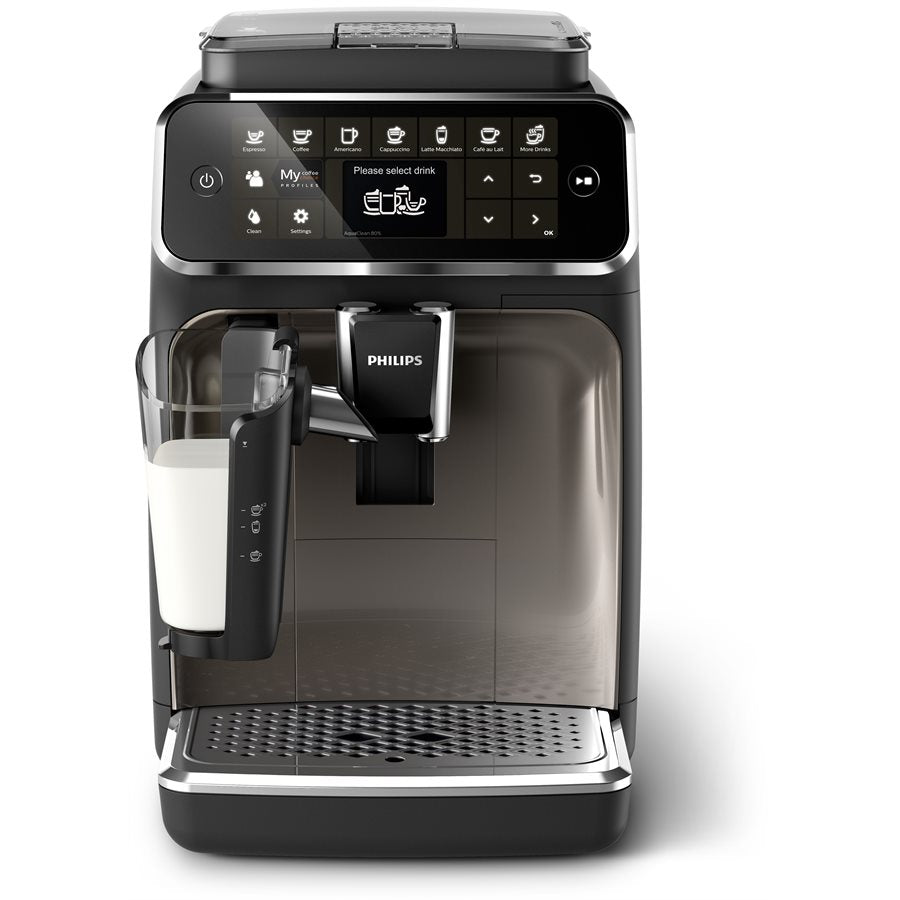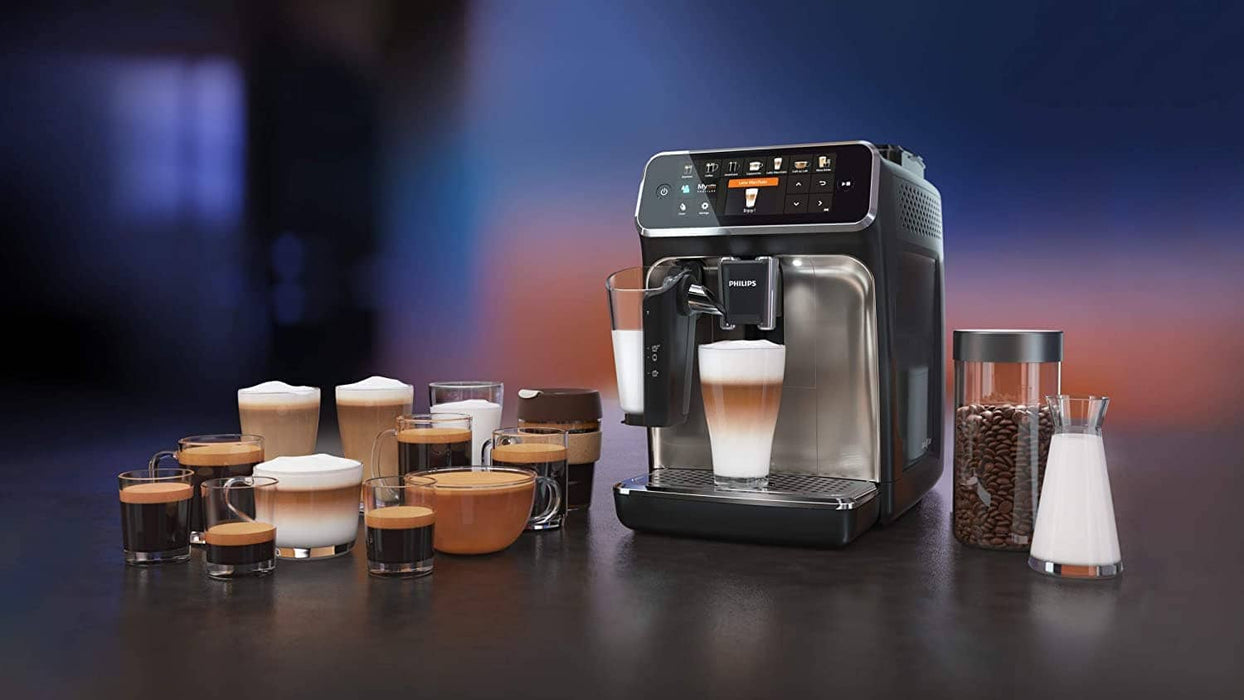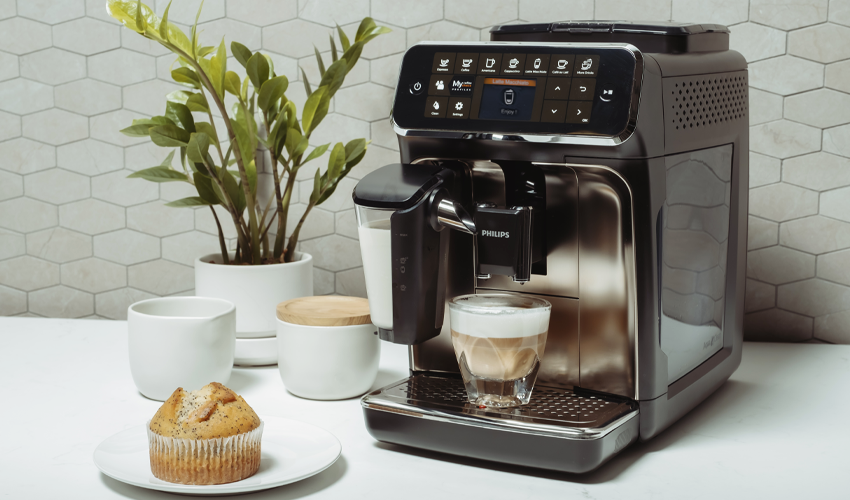#1: Philips LatteGo 5400

- Wide variety of drinks
- Advanced customization
- User profile options
#2: Philips LatteGo 4300

- Basic milk frother
- Small water tank
- Noisy grinder
As a long-time coffee enthusiast, I’ve spent years exploring different machines to find the perfect balance between convenience and quality. When I decided to upgrade, the Philips LatteGo 5400 and Philips LatteGo 4300 caught my attention. Both machines promised ease of use, excellent customization options, and, of course, great coffee. After using both, I found myself leaning toward the 5400. Here’s why I think the Philips LatteGo 5400 is the better option, along with a detailed comparison of the two.

Initial Setup and User Experience: Philips LatteGo 5400 vs 4300
When I unboxed both the Philips LatteGo 5400 and the Philips LatteGo 4300, the first thing that struck me was their design. The 5400’s sleek finish, complete with stainless steel accents, made it feel more premium and modern. The 4300, while still attractive, lacked some of the refined touches that the 5400 offered.
Setting up both machines was straightforward. Each came with the essential tools: the LatteGo milk system, a measuring scoop, AquaClean water filter, and a user manual. While the 4300 provided a seamless setup process, the 5400’s advanced touchscreen interface made calibration and initial settings even easier.
Exploring Customization: Why the Philips LatteGo 5400 Stands Out
Customization is crucial for me because I like tailoring every cup of coffee to my mood. Both machines allow you to adjust coffee strength, milk quantity, and drink size. However, the Philips LatteGo 5400 takes it a step further with its ability to save personalized settings for up to four user profiles. In my household, where everyone has their own preferences, this feature became invaluable.
The Philips LatteGo 4300, while offering solid customization, doesn’t include as many drink options. With the 5400, I could choose from 12 beverages, including flat white, café au lait, and ristretto. The variety gave me the flexibility to experiment with new drinks, which was something I genuinely enjoyed.

Brewing Quality: A Key Difference Between the Philips LatteGo 5400 and 4300
Brewing coffee with both machines was a delight, but the 5400 offered a more polished experience. Its Aroma Extract system and ceramic burr grinder deliver a perfectly balanced brew every time. I found the espresso shots rich, full-bodied, and topped with a luscious crema.
The 4300 didn’t fall far behind—it also produces great espresso and uses the same grinder and extraction system. However, the difference became apparent when I experimented with more intricate drinks. The 5400’s precision ensured a consistent flavor profile, even with milk-based beverages, making it feel more versatile overall.

Milk Frothing: LatteGo System in Action
Milk frothing is an area where both machines shine, thanks to the innovative LatteGo milk system. I’ve always found traditional milk frothers a hassle to clean, but the LatteGo system changed that for me. It uses just two parts—a milk container and a frothing chamber—making setup and cleaning incredibly easy.
For cappuccinos and lattes, both machines produced creamy froth, though the 5400’s frother operated slightly more efficiently. The 5400’s frothing was quieter and felt faster, which made a noticeable difference during my busy mornings.
Maintenance Made Simple
One of the reasons I gravitated toward the Philips LatteGo series in the first place was the promise of low-maintenance upkeep. Both machines lived up to this promise, but the Philips LatteGo 5400 went the extra mile with more intuitive reminders for cleaning and descaling.
With the AquaClean filter, both machines can brew up to 5,000 cups without requiring descaling. This feature alone made maintenance a breeze, as it saved me from worrying about mineral buildup. Additionally, the 5400’s touchscreen interface provided clear and timely prompts for filter changes and brew group cleaning, making the entire process feel effortless.
Performance During Busy Mornings
I run on coffee—especially on hectic mornings. During these times, I appreciated how quickly the Philips LatteGo 5400 could brew my go-to cappuccino. The larger bean hopper and water reservoir meant I didn’t have to refill the machine as often, which was a game-changer for my daily routine.
The 4300, while reliable, required more frequent refills. This minor inconvenience added up over time, especially when I was hosting friends or family. In contrast, the 5400’s larger capacity made it better suited for households with multiple coffee drinkers or those who entertain often.
Noise Levels: A Subtle Yet Noticeable Difference
Both machines are quieter than other espresso makers I’ve used in the past, but the Philips LatteGo 5400 has an edge in noise reduction. Its grinder and milk frother emitted less noise, which I appreciated during early mornings or late-night coffee sessions.
While the 4300 wasn’t overly loud, the quieter operation of the 5400 contributed to its overall premium feel.
Philips LatteGo 5400 vs 4300: Ideal Use Cases
After using both machines extensively, I believe each has its ideal audience:
Philips LatteGo 4300: Best for those who want a reliable, straightforward coffee machine that covers all the basics. It’s perfect for individuals or smaller households who primarily enjoy classic drinks like espresso, coffee, and cappuccino.
Philips LatteGo 5400: Ideal for coffee enthusiasts who value versatility and customization. With its wider drink selection, advanced user interface, and user profiles, it’s a fantastic choice for larger households or anyone who enjoys experimenting with different coffee beverages.
Product Review Conclusion: Philips LatteGo 5400 vs 4300
The Philips LatteGo 5400 and Philips LatteGo 4300 are both excellent machines, but the 5400 stands out as the better choice for its advanced features, broader drink options, and user-friendly interface. While it comes at a higher price point, the added convenience and versatility make it a worthwhile investment for coffee enthusiasts like me.
If you’re someone who values a wide range of beverages, seamless customization, and effortless maintenance, the Philips LatteGo 5400 is the clear winner. However, if you’re on a tighter budget or primarily enjoy straightforward coffee drinks, the Philips LatteGo 4300 is still a solid option.
Ultimately, both machines bring the convenience of a fully automatic espresso maker into your home, but the Philips LatteGo 5400 provides that extra touch of excellence that makes every cup feel special.
Frequently Asked Questions About Philips LatteGo 5400 vs 4300
Q1: What are the main differences between the Philips LatteGo 5400 and 4300?
A: The main differences include the number of beverage options and user profiles. The Philips LatteGo 5400 offers 12 beverages and supports up to four user profiles, while the 4300 provides a more basic selection of drinks and fewer customization options.
Q2: Is the user interface different between the two models?
A: Yes, the Philips LatteGo 5400 features a color touchscreen display that is more advanced and user-friendly compared to the simpler interface of the 4300, which uses a basic button system for navigation.
Q3: How do the brewing performances compare?
A: Both machines offer high-quality brewing, but the Philips LatteGo 5400 has a more precise ceramic burr grinder and an improved Aroma Extract system, which results in richer espresso shots and better flavor consistency.
Q4: Are the milk frothing systems the same?
A: Yes, both machines use the LatteGo milk system, which consists of two parts for easy cleaning. However, the 5400's frothing system operates a bit more quietly and efficiently, providing slightly better results for milk-based drinks.
Q5: What is the maintenance like for both machines?
A: Both the Philips LatteGo 5400 and 4300 feature easy maintenance with automatic cleaning cycles and the AquaClean filter, which allows for up to 5,000 cups without descaling. The 5400, however, provides more intuitive maintenance prompts on its touchscreen.
Q6: Which model is quieter during operation?
A: The Philips LatteGo 5400 is designed to operate more quietly than the 4300, particularly when grinding beans and frothing milk, making it more suitable for early morning use.
Q7: Can I customize my coffee preferences on both machines?
A: Yes, both machines allow customization of coffee strength, milk quantity, and drink size. However, the 5400 supports saving personalized settings for multiple user profiles, making it more versatile for households with different coffee preferences.
Q8: Which model is better for larger households or entertaining guests?
A: The Philips LatteGo 5400 is better suited for larger households or entertaining guests due to its larger bean hopper and water reservoir, which means less frequent refills and a wider selection of drinks for everyone to enjoy.
Q9: Are both models capable of making specialty coffee drinks?
A: Yes, both models can make a variety of specialty drinks, but the Philips LatteGo 5400 offers a greater selection, including unique options like flat white and café au lait, making it more appealing for those who enjoy experimenting with different coffee styles.
Q10: Is there a significant price difference between the two models?
A: Yes, the Philips LatteGo 5400 is typically priced higher than the 4300 due to its advanced features, additional beverage options, and superior user interface. However, many users find the extra cost justified for the added convenience and quality.
